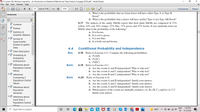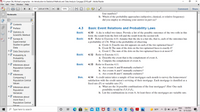
A First Course in Probability (10th Edition)
10th Edition
ISBN: 9780134753119
Author: Sheldon Ross
Publisher: PEARSON
expand_more
expand_more
format_list_bulleted
Question
4.18- a and b part
4.19-a and b part
i have attached he 4.11 for reference

Transcribed Image Text:2 R. Lyman Ott, Michael Longnecker - An Introduction to Statistical Methods and Data Analysis-Cengage (2016).pdf - Adobe Reader
File Edit View Window Help
211 (224 of 1179)
125%
Comment
Share
c. What is the probability that an Asian donor will have either Type A or Type B
Bookmarks
blood?
d. What is the probability that a donor will have neither Type A nor Type AB blood?
4.17 The makers of the candy M&Ms report that their plain M&Ms are composed of 15%
yellow, 10% red, 20% orange, 25% blue, 15% green, and 15% brown. If you randomly select an
P Contents
P Preface
M&M, what is the probability of the following?
a. It is brown.
b. It is red or green.
c. It is not blue.
d. It is both red and brown.
+W Statistics &
Scientific Method
ET Surveys &
Experimental
Studies to gather
Data
4.4
Conditional Probability and Independence
+ P Data Description
ET Probability &
Bus.
4.18 Refer to Exercise 4.11. Compute the following probabilities:
а. Р(A|B)
b. P(A|C)
с. Р(B|C)
4.19 Refer to Exercise 4.11.
Probability
Distributions
+P Inferences about
Baslc
Population Central
a. Are the events A and B independent? Why or why not?
b. Are the events A and Cindependent? Why or why not?
c. Are the events B and C independent? Why or why not?
Values
EP Inferences
Comparing 2
Population Central
Values
Baslc
4.20 Refer to Exercise 4.14.
a. Are the events A and B independent? Justify your answer.
b. Are the events A and C independent? Justify your answer.
c. Are the events A and D independent? Justify your answer.
d. Which pair(s) of the events are mutually exclusive: (A, B), (B, C.), and/or (A, C)?
Justify your answer.
+P Inferences about
Population
Variances
+ P Inferences about
more than 2
Population Central
Values
ENG
1:03 РМ
P Type here to search
90°F
IN
9/15/2021
近

Transcribed Image Text:2 R. Lyman Ott, Michael Longnecker - An Introduction to Statistical Methods and Data Analysis-Cengage (2016).pdf - Adobe Reader
File Edit View Window Help
210 (223 of 1179)
125%
Comment
Share
four numbers?
Bookmarks
b. Which of the probability approaches (subjective, classical, or relative frequency)
did you employ in obtaining your answer in part (a)?
P Contents
P Preface
4.3
Basic Event Relations and Probability Laws
+W Statistics &
Baslc
4.10 A die is rolled two times. Provide a list of the possible outcomes of the two rolls in this
Scientific Method
form: the result from the first roll and the result from the second roll.
ET Surveys &
Baslc
4.11 Refer to Exercise 4.10. Assume that the die is a fair die, that is, each of the outcomes has
a probability of 1/36. What is the probability of observing
Experimental
Studies to gather
a. Event A: Exactly one dot appears on each of the two upturned faces?
b. Event B:The sum of the dots on the two upturned faces is exactly 4?
c. Event C: The sum of the dots on the two upturned faces is at most 4?
Data
+ P Data Description
ET Probability &
Baslc
4.12 Refer to Exercise 4.11.
Probability
Distributions
a. Describe the event that is the complement of event A.
b. Compute the complement of event A.
+P Inferences about
Baslc
4.13 Refer to Exercise 4.11.
a. Are events.
b. Are events A and C mutually exclusive?
c. Are events B and C mutually exclusive?
Population Central
and B mutually exclusive?
Values
EP Inferences
Bus.
Comparing 2
Population Central
Values
4.14 A credit union takes a sample of four mortgages each month to survey the homeowners'
satisfaction with the credit union's servicing of their mortgage. Each mortgage is classified as a
fixed rate (F) or variable rate (V).
+P Inferences about
Population
Variances
a. What are the 16 possible combinations of the four mortgages? Hint: One such
possibility would be F¡V½V3F4-
b. List the combinations in event A: At least three of the mortgages are variable rate.
+ P Inferences about
more than 2
Population Central
Values
ENG
1:04 PM
P Type here to search
90°F
IN
9/15/2021
Expert Solution
This question has been solved!
Explore an expertly crafted, step-by-step solution for a thorough understanding of key concepts.
This is a popular solution
Trending nowThis is a popular solution!
Step by stepSolved in 4 steps with 2 images

Knowledge Booster
Similar questions
- Answer to number one and steps basic mathematics collegearrow_forwardv Question Completion Status: QUESTION 17 Given: X = {2,6,2,7,4,5} Y = (3,2,4,3,1,8) Calculate: ΣΧΥ 91 QUESTION 18 Given: X = {2,6.2.7.4.5) Y = (3.2,4.3.1,8) Calculate. 134 Click Save and Submit to save and submit. Click Save All Answers to save all anst to search hparrow_forward30. Using the picture, find the value of a and b.arrow_forward
- Homework: Section 8.1 Homework Score: 0 of 1 pt 3 of 20 (0 complete) ▼ 8.1.14 A menu offers a choice of 2 salads, 9 main dishes, and 7 desserts. How many different meals consisting of one salad, one main dish, and one dessert are possible? There are different possible meals. (Type a whole number.) Enter your answer in the answer box and then click Check Answer. All parts showing Clear All P Type here to search 梦 $arrow_forwardHelp please.. i got wrong explanation 2 times.. help with right answerarrow_forward7 3 Let u= - 5 and v = 2 . Compute and compare u•v, ||u||?, M², and ||u + v||?. Do not use the Pythagorean Theorem. - 11 u•v= (Simplify your answer.) (Simplify your answer.) |v|2 = (Simplify your answer.) %3! Ju + v||2 = (Simplify your answer.) %3! 0 and | ul2 + ||v||? u+ v||? both imply that the vectors u and v The statements u•v orthogonal.arrow_forward
arrow_back_ios
arrow_forward_ios
Recommended textbooks for you
 A First Course in Probability (10th Edition)ProbabilityISBN:9780134753119Author:Sheldon RossPublisher:PEARSON
A First Course in Probability (10th Edition)ProbabilityISBN:9780134753119Author:Sheldon RossPublisher:PEARSON

A First Course in Probability (10th Edition)
Probability
ISBN:9780134753119
Author:Sheldon Ross
Publisher:PEARSON
